

Alan Kitching. Bob Gill. Alan Fletcher. Alan Fletcher Graphic Designer (1931-2006) Alan Fletcher: fifty years of graphic work (and play) 11 November 2006 - 18 February 2007 Designed to be opened at random, The Art of Looking Sideways, Alan Fletcher’s 2001 book, is an unfailing source of wit, elegance and inspiration.

At over a thousand pages, it is a spectacular treatise on visual thinking, one that illustrates the designer’s sense of play and his broad frame of reference. While designers and design students rifle through its pages for ideas, others enjoy its gently provocative mind-teasers. Alan Fletcher is one of the most influential figures in post-war British graphic design. Born to a British family in Kenya 1931, Fletcher came to Britain as a five year-old after his father became terminally ill to be bought up by his mother and grandparents in West London.
During the 1950s he attended four different art schools, each one more forward looking and cosmopolitan than the last. David carson. Wim Crouwel. Work[edit] In addition to his work as a graphic designer, he was also active in the educational field.

In the 1950s he worked as a teacher at the Royal Academy for Art and Design in 's-Hertogenbosch (currently called Akademie Voor Kunst en Vormgeving St. Joost or AKV|St. Joost) and at the predecessor of what is now the Gerrit Rietveld Academie. Between 1965 and 1985 he was connected to the department of industrial design of the Delft University of Technology. Awards[edit] Ed fella. Alison Carmichael. Marian Bantjes. Katherine mccoy. Katherine McCoy was born in Decatur, Illinois, in 1945.

She studied industrial design at Michigan State University before joining Unimark International in 1967. She went on to work at Chrysler Corporation and Omnigraphics, Inc. In 1971, McCoy became co-chair, with her husband Mike McCoy, of the design department at Cranbrook Academy of Art, which they continued to direct until 1995. By the 1980s, their sometimes controversial programme had established itself as one of the most innovative in American design education, producing a stream of graduates who have gone on to make their own mark in the profession.
April greiman. Jeff keedy. An Interview with Mr.
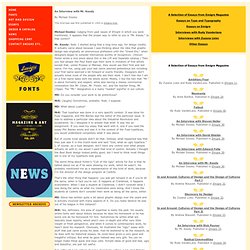
Keedy By Michael Dooley This interview was first published in 1994 in Emigre #30. Michael Dooley: Judging from past issues of Emigre in which you were mentioned, it appears that the proper way to refer to you is "Mr. Keedy. " Mr. MD: Do you consider your work to be pretentious? Piet Zwart. Eric Gill. Edward Johnston. Edward Johnston, 1902 Early life[edit] The family returned to England in 1875.

Hendrik Nicolaas Werkman. Monument for the 10 executed by the Gestapo.
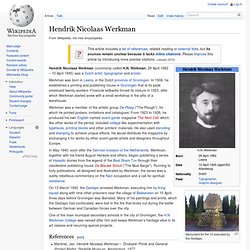
Werkman was a member of the artists' group De Ploeg ("The Plough"), for which he printed posters, invitations and catalogues. From 1923 to 1926, he produced his own English-named avant-garde magazine The Next Call, which, like other works of the period, included collage-like experimentation with typefaces, printing blocks and other printers' materials. He also used stenciling and stamping to achieve unique effects. He would distribute the magazine by exchanging it for works by other avant-garde artists and designers throughout Europe. In May 1940, soon after the German invasion of the Netherlands, Werkman, together with his friend August Henkels and others, began publishing a series of Hassidic stories from the legend of the Baal Shem Tov through their clandestine publishing house De Blauwe Schuit ("The Blue Barge").
One of the main municipal secondary schools in the city of Groningen, the H.N. Armin Hofmann. Armin Hofmann (HonRDI) (born June 29, 1920)[1] is a Swiss graphic designer.
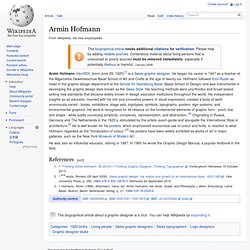
He began his career in 1947 as a teacher at the Allgemeine Gewerbeschule Basel School of Art and Crafts at the age of twenty-six. Hofmann followed Emil Ruder as head of the graphic design department at the Schule für Gestaltung Basel (Basel School of Design) and was instrumental in developing the graphic design style known as the Swiss Style.
His teaching methods were unorthodox and broad based, setting new standards that became widely known in design education institutions throughout the world. Wolfgang weingart. Peter saville. Neville Brody. Neville Brody (born 23 April 1957 in London) is an English graphic designer, typographer and art director.[1]
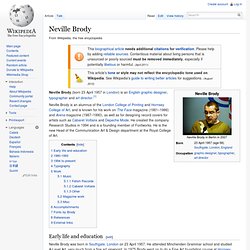
Bob Cobbing. Bob Cobbing (30 July 1920 – 29 September 2002) was a British sound, visual, concrete and performance poet who was a central figure in the British Poetry Revival.

Early life[edit] Cobbing was born in Enfield and grew up within the Plymouth Brethren. He attended Enfield Grammar School and then trained as an accountant. He later went to Bognor Training College to become a teacher. During the Second World War, he was a conscientious objector. Stéphane Mallarmé. Biography[edit] On 10 August 1863, he married Maria Christina Gerhard.
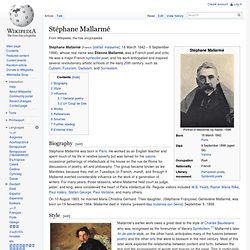
Their daughter, (Stéphanie Françoise) Geneviève Mallarmé, was born on 19 November 1864. Mallarmé died in Valvins (present-day Vulaines-sur-Seine) September 9, 1898. Style[edit] Eugen Gomringer. Eugen Gomringer, Switzerland | b. 1925 The Book of Hours and Constellations [PDF, 111k] Something Else? Press, 1968. Edited by Jerome Rothenberg. UbuWeb facsimile edition edited and redacted by Lucia della Paolera. Individual Concrete Poems Silencio Ping-Pong Wind o. Guillaume Apollinaire.